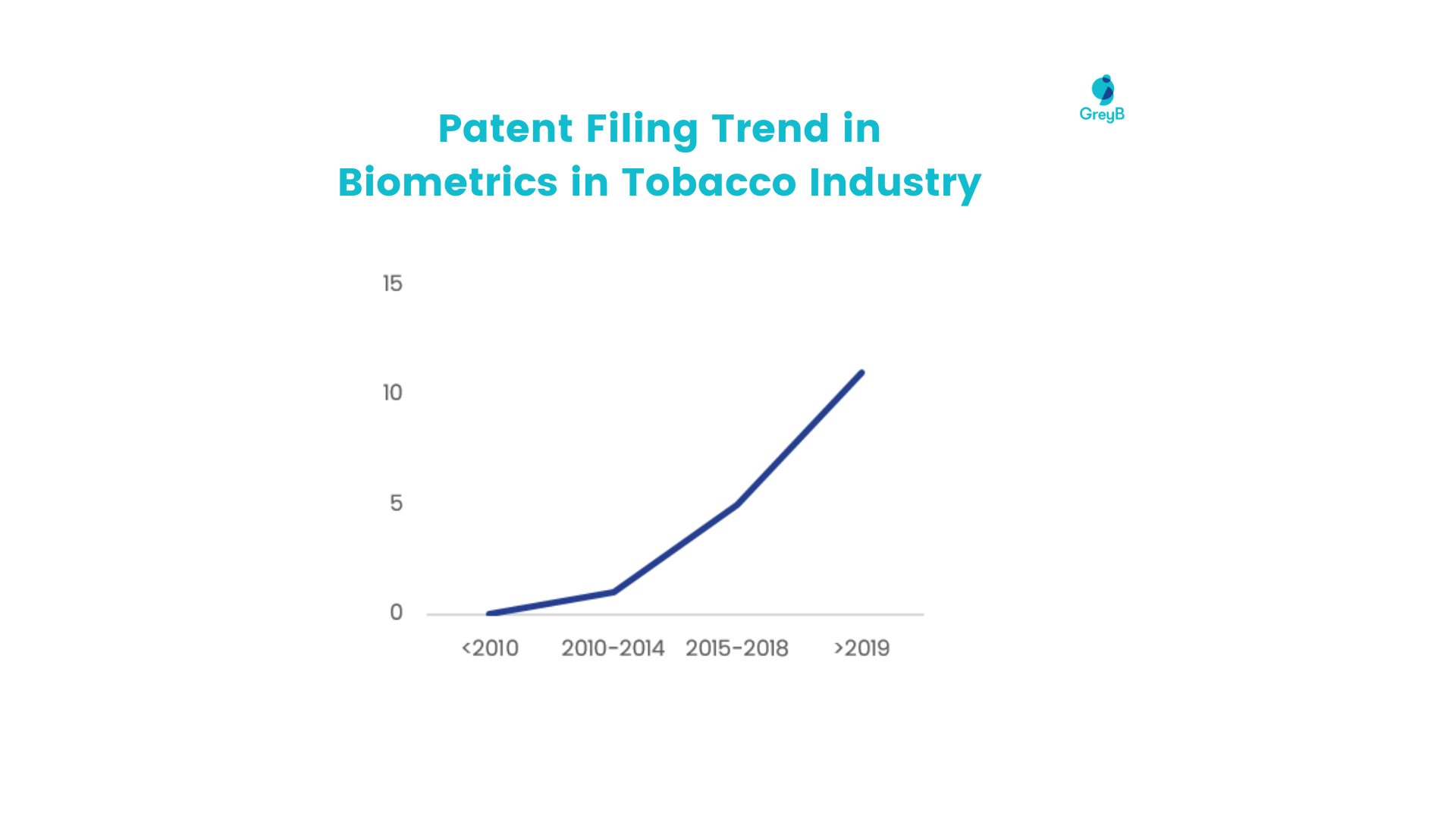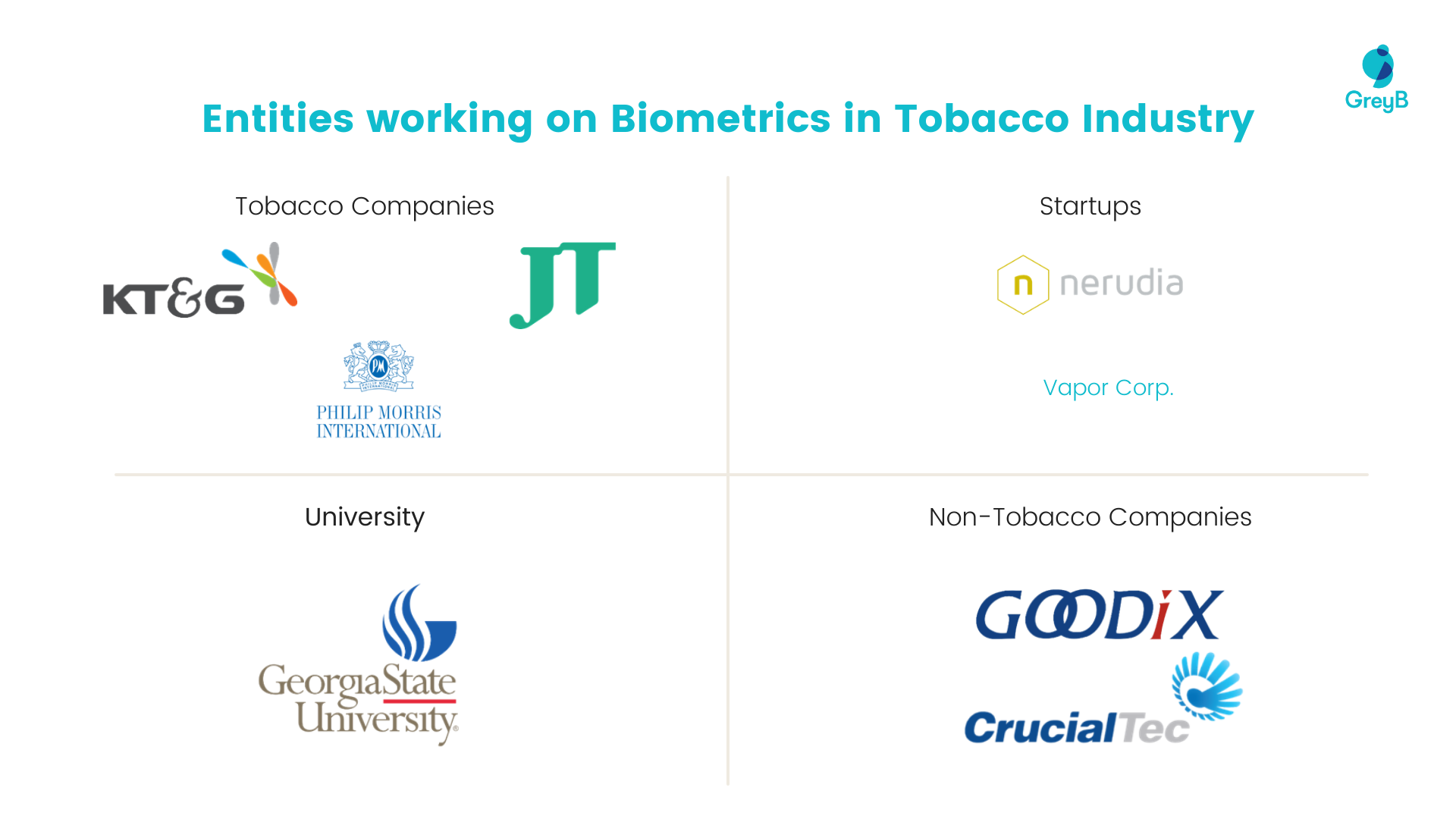Making tobacco products more secure, personalized, and intelligent is the next big challenge the Tobacco industry is trying to overcome. With that vision, R&D heads are implementing new technologies in the domain.
Earlier, we discussed how age verification technologies are being introduced in the industry. Biometrics is another technology trend that can make the tobacco industry safer and more intelligent.
Many companies and startups have been researching this area. Resultantly, patent filing in biometrics by the top tobacco companies is on the rise.

Will the implementation of Biometrics in tobacco products give the industry a whole new direction? Which companies will take the lead? And what are the developments made so far?
Let’s jump in.
Who is working on Biometrics Technology in the Tobacco Industry?

Where is the industry headed?
While one of the major roles of biometrics in the tobacco industry is enabling age validation technology, research by companies operating in the space also suggests other applications like identifying the user’s emotional state.
Identifying the emotional state by scanning a user’s pupil

Research by KT&G, a south-Korean company, suggests using biometric information sourced from the image of a user’s pupil.
This image is then used to compute the user’s emotional state through which different types of cartridges associated with an aerosol device can be recommended, thereby improving consumer satisfaction.
Impacts include minimizing the negative emotional state of users (e.g., cartridges containing vitamin D) or even enhancing a positive emotional state (e.g., cartridges containing menthol)
The company has also filed a patent (US20220287378A1) for this technology.
Automating the use of aerosol devices based on a user’s biometrics

Research by JT suggests using biological information like “blood pressure, heart rate, blood oxygen concentration, and oxygen saturation”, could possibly be used to limit the functioning of aerosol devices.
Unlike fingerprint or touch-based systems, JT’s approach seems to involve the use of reflected waves (like natural light, infrared, and radio waves), which can be captured by sensors such as a camera, making the process contactless.
The research further suggests monitoring biometric information at two points, such as before and after inhalation of a puff. If the conditions exceed certain predetermined thresholds, like an increase in blood pressure, device operation could be inhibited.
JT has even filed a patent (WO2021234801A1) against this technology.
Using biometric data to assess stress levels
Another research by the company suggests devices equipped with sensors for measuring biometric data.
This biometric data can be used to develop stress state information, which in a way, seems similar to the research carried out by KT&G.
The types of biological data that can be measured to generate stress information include pulse, sweat, saliva, heartbeat, etc.
However, unlike the KT&G system, which suggests using different types of cartridges, the research by JT suggests the generation of recommendations, such as messages (take a break, location of rest facilities, etc.), using the biometric data.
Like the previous tech, JT filed a patent (WO2022029936A1) to protect this innovation.
Japan Tobacco (JT/JTI) has been pretty active in researching biometric technology. The company has researched multiple variations of using biometric in tobacco products.
The other research by the company includes pulse-based techniques for authentication, tooth-print-based biometric systems, and fingerprint technology for aerosol devices.
Want to know about these technologies in detail? Our Tobacco Industry Trend Report comprises all the information you need.
Fill out the form below, and the report will be delivered to your inbox!
Not only tobacco but even non-tobacco companies have conducted research regarding biometric systems in e-cigarettes and vapes.
Let’s look at a few of the research in the field.
What are non-tobacco companies doing in this field?
Tracking and restricting usage by bio-tracing
Shenzhen Goodix Technology, a Chinese company that develops and sells fingerprint sensors, touch controllers, etc., for mobile phones and tablets, is researching bio-tracing of consumable devices like e-cigarettes for usage tracking, usage restriction, etc. Fingerprints, blood, and heartbeat are among the means for tracking.
The company has a patent (US10806178B1) for this technology.
Unlocking vaporizers with user’s biometrics
CrucialTec, another non-tobacco company from South Korea that works in hardware technology, is researching biometric (fingerprint or iris) authentication-driven vaporizer devices. They have also filed a patent (KR20210080943A) to protect their innovation.
Conclusion
Since biometric data is personal and private, data breaches can pose serious consequences. JT is conducting research for securing devices through biometrics while protecting users’ biometric data.
Their research suggests the generation of encryption keys for biometric authentication, such that an attacker can only obtain encrypted data in case of remote attacks.
Businesses worldwide are interested in conducting research on many applications in this area. Therefore, biometric technology can revolutionize the tobacco industry. It’ll be interesting to see how the technology grows.
Authored By: Prateek and Sushant, Patent Intelligence
Edited By: Ridhima Mahajan, Marketing
Also read: The State of Tobacco Industry 2023: Navigating through the FDA Regulations










